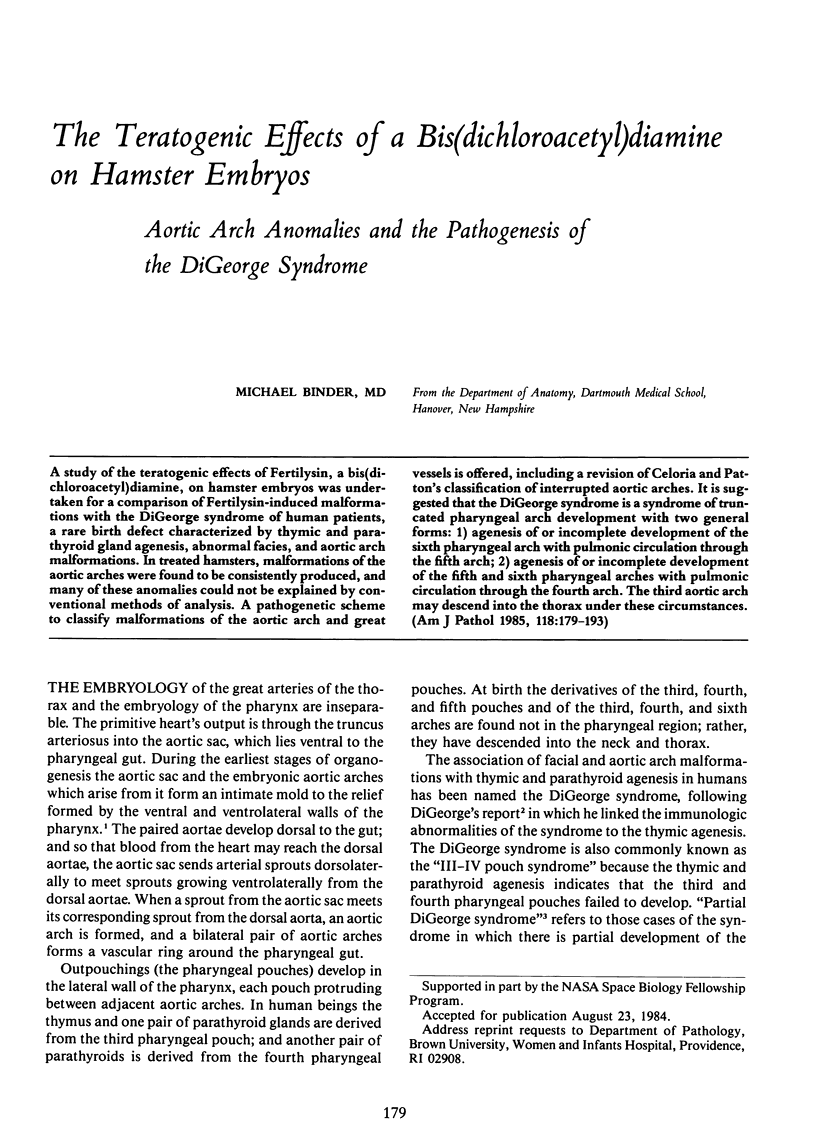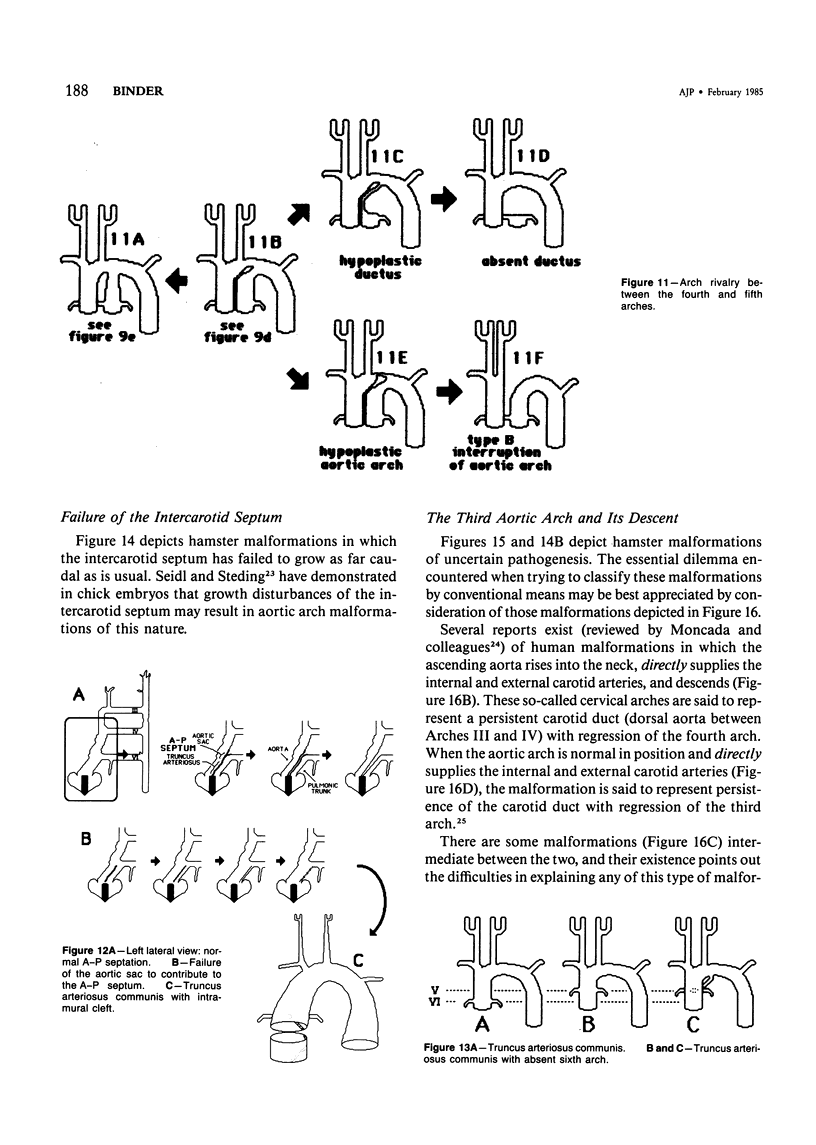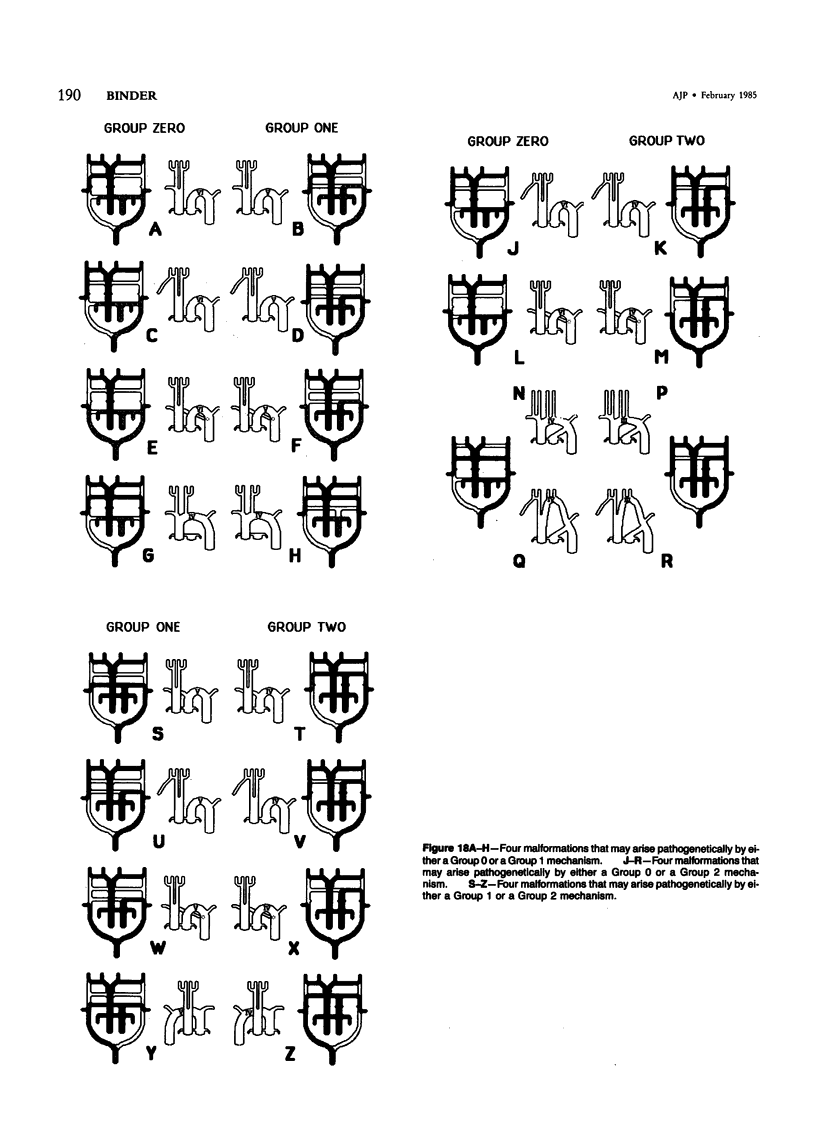Abstract
A study of the teratogenic effects of Fertilysin, a bis(dichloroacetyl)diamine, on hamster embryos was undertaken for a comparison of Fertilysin-induced malformations with the DiGeorge syndrome of human patients, a rare birth defect characterized by thymic and parathyroid gland agenesis, abnormal facies, and aortic arch malformations. In treated hamsters, malformations of the aortic arches were found to be consistently produced, and many of these anomalies could not be explained by conventional methods of analysis. A pathogenetic scheme to classify malformations of the aortic arch and great vessels is offered, including a revision of Celoria and Patton's classification of interrupted aortic arches. It is suggested that the DiGeorge syndrome is a syndrome of truncated pharyngeal arch development with two general forms: 1) agenesis of or incomplete development of the sixth pharyngeal arch with pulmonic circulation through the fifth arch; 2) agenesis of or incomplete development of the fifth and sixth pharyngeal arches with pulmonic circulation through the fourth arch. The third aortic arch may descend into the thorax under these circumstances.
Full text
PDF














Selected References
These references are in PubMed. This may not be the complete list of references from this article.
- BARRY A. The aortic arch derivatives in human adult. Anat Rec. 1951 Oct;111(2):221–238. doi: 10.1002/ar.1091110207. [DOI] [PubMed] [Google Scholar]
- BLAKE H. A., MANION W. C. Thoracic arterial arch anomalies. Circulation. 1962 Aug;26:251–265. doi: 10.1161/01.cir.26.2.251. [DOI] [PubMed] [Google Scholar]
- Bockman D. E., Kirby M. L. Dependence of thymus development on derivatives of the neural crest. Science. 1984 Feb 3;223(4635):498–500. doi: 10.1126/science.6606851. [DOI] [PubMed] [Google Scholar]
- CELORIA G. C., PATTON R. B. Congenital absence of the aortic arch. Am Heart J. 1959 Sep;58:407–413. doi: 10.1016/0002-8703(59)90157-7. [DOI] [PubMed] [Google Scholar]
- Conley M. E., Beckwith J. B., Mancer J. F., Tenckhoff L. The spectrum of the DiGeorge syndrome. J Pediatr. 1979 Jun;94(6):883–890. doi: 10.1016/s0022-3476(79)80207-3. [DOI] [PubMed] [Google Scholar]
- HARLEY H. R. The development and anomalies of the aortic arch and its branches with the report of a case of right cervical aortic arch and intrathoracic vascular ring. Br J Surg. 1959 May;46:561–573. doi: 10.1002/bjs.18004620003. [DOI] [PubMed] [Google Scholar]
- Kilburn K. H., Hess R. A., Lesser M., Oster G. Perinatal death and respiratory apparatus dysgenesis due to a bis (dichloroacetyl) diamine. Teratology. 1982 Oct;26(2):155–162. doi: 10.1002/tera.1420260207. [DOI] [PubMed] [Google Scholar]
- Kutsche L. M., Van Mierop L. H. Cervical origin of the right subclavian artery in aortic arch interruption: pathogenesis and significance. Am J Cardiol. 1984 Mar 15;53(7):892–895. doi: 10.1016/0002-9149(84)90519-8. [DOI] [PubMed] [Google Scholar]
- Lerberg D. B. Abbott's artery. Ann Thorac Surg. 1982 Apr;33(4):415–416. doi: 10.1016/s0003-4975(10)63242-0. [DOI] [PubMed] [Google Scholar]
- Lischner H. W. DiGeorge syndrome(s). J Pediatr. 1972 Nov;81(5):1042–1044. doi: 10.1016/s0022-3476(72)80575-4. [DOI] [PubMed] [Google Scholar]
- Moerman P., Goddeeris P., Lauwerijns J., Van der Hauwaert L. G. Cardiovascular malformations in DiGeorge syndrome (congenital absence of hypoplasia of the thymus). Br Heart J. 1980 Oct;44(4):452–459. doi: 10.1136/hrt.44.4.452. [DOI] [PMC free article] [PubMed] [Google Scholar]
- Moncada R., Shannon M., Miller R., White H., Friedman J., Shuford W. H. The cervical aortic arch. Am J Roentgenol Radium Ther Nucl Med. 1975 Nov;125(3):591–601. doi: 10.2214/ajr.125.3.591. [DOI] [PubMed] [Google Scholar]
- Oster G., Kilburn K. H., Siegal F. P. Chemically induced congenital thymic dysgenesis in the rat: a model of the DiGeorge syndrome. Clin Immunol Immunopathol. 1983 Jul;28(1):128–134. doi: 10.1016/0090-1229(83)90196-4. [DOI] [PubMed] [Google Scholar]
- Oster G., Salgo M. P., Taleporos P. Embryocidal action of a bis(dichloroacetyl)-diamine: an oral abortifacient for rats. Am J Obstet Gynecol. 1974 Jul 1;119(5):583–588. doi: 10.1016/0002-9378(74)90117-3. [DOI] [PubMed] [Google Scholar]
- Pratt R. M., Larsen M. A., Johnston M. C. Migration of cranial neural crest cells in a cell-free hyaluronate-rich matrix. Dev Biol. 1975 Jun;44(2):298–305. doi: 10.1016/0012-1606(75)90400-5. [DOI] [PubMed] [Google Scholar]
- ROBERTS W. C., MORROW A. G., BRAUNWALD E. Complete interruption of the aortic arch. Circulation. 1962 Jul;26:39–59. doi: 10.1161/01.cir.26.1.39. [DOI] [PubMed] [Google Scholar]
- Robinson H. B., Jr DiGeorge's or the III-IV pharyngeal pouch syndrome: pathology and a theory of pathogenesis. Perspect Pediatr Pathol. 1975;2:173–206. [PubMed] [Google Scholar]
- Seidl W., Steding G. Contribution to the development of the heart. Part III: The aortic arch complex. Normal development and morphogenesis of congenital malformation. Thorac Cardiovasc Surg. 1981 Dec;29(6):359–368. doi: 10.1055/s-2007-1023514. [DOI] [PubMed] [Google Scholar]
- Taleporos P., Salgo M. P., Oster G. Teratogenic action of bis(dichloroacetyl)diamine on rats: patterns of malformations produced in high incidence at time-limited periods of development. Teratology. 1978 Aug;18(1):5–15. doi: 10.1002/tera.1420180104. [DOI] [PubMed] [Google Scholar]
- Van Mierop L. H., Kutsche L. M. Interruption of the aortic arch and coarctation of the aorta: pathogenetic relations. Am J Cardiol. 1984 Oct 1;54(7):829–834. doi: 10.1016/s0002-9149(84)80215-5. [DOI] [PubMed] [Google Scholar]
- Van Praagh R., Van Praagh S. Persistent fifth arterial arch in man. Congenital double-lumen aortic arch. Am J Cardiol. 1969 Aug;24(2):279–282. doi: 10.1016/0002-9149(69)90417-2. [DOI] [PubMed] [Google Scholar]
- Van Praagh R., Van Praagh S. The anatomy of common aorticopulmonary trunk (truncus arteriosus communis) and its embryologic implications. A study of 57 necropsy cases. Am J Cardiol. 1965 Sep;16(3):406–425. doi: 10.1016/0002-9149(65)90732-0. [DOI] [PubMed] [Google Scholar]


